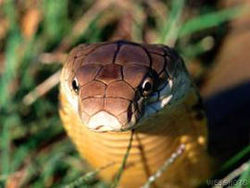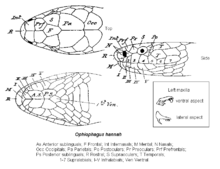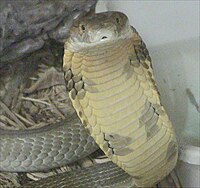King cobra: Difference between revisions
Hammersfan (talk | contribs) |
|||
| Line 36: | Line 36: | ||
==Description== |
==Description== |
||
Sometimes the King Cobra is pale olive or yellow olive in color with a pale yellow veneer.<ref name="mehrtens"/> Individuals from India are crossbanded with yellow and a black posterior, whereas Chinese variants are black-brown crossbanded with pale white or ivory.<ref name="mehrtens"/> Male King Cobras tend to be longer and thicker than female King Cobras. |
Sometimes the King Cobra is pale olive or yellow olive in color with a pale yellow veneer.<ref name="mehrtens"/> Individuals from India are crossbanded with yellow and a black posterior, whereas Chinese variants are black-brown crossbanded with pale white or ivory.<ref name="mehrtens"/> Male King Cobras tend to be longer and thicker than female King Cobras.ytuylkjhl |
||
==Habitat== |
==Habitat== |
||
Revision as of 17:37, 3 March 2008
- For the malt liquor brand, see King Cobra (malt liquor).
- For the movie, see King Cobra (film).
| King Cobra | |
|---|---|

| |
| Scientific classification | |
| Kingdom: | |
| Phylum: | |
| Class: | |
| Order: | |
| Suborder: | |
| Family: | |
| Genus: | Ophiophagus
|
| Species: | O. hannah
|
| Binomial name | |
| Ophiophagus hannah | |

| |
| Range (in red) | |
The King Cobra (Ophiophagus hannah) is the world's longest venomous snake, growing to a length of 18.5 ft (5.7 m)[1] and a weight of up to 20 lbs. (9 kg.)[2] The venom of the King Cobra is primarily neurotoxic, and the snake is fully capable of killing a human with a single bite.[3] The mortality rate can be as high as 75%, but most bites involve nonfatal amounts of venom.[3][4][5]
Description
Sometimes the King Cobra is pale olive or yellow olive in color with a pale yellow veneer.[1] Individuals from India are crossbanded with yellow and a black posterior, whereas Chinese variants are black-brown crossbanded with pale white or ivory.[1] Male King Cobras tend to be longer and thicker than female King Cobras.ytuylkjhl
Habitat
The King Cobra lives in much of mainland Southeast Asia and throughout the dense highland forest ranging from Northern India to Southeastern China through the Malay Peninsula to western Indonesia, Thailand and the Philippines.[1][6] The snake has a preference for living in areas dotted with lakes and streams. King Cobra populations have dropped in some areas of its range due to the destruction of forests, but despite this the snake is not listed by the IUCN as in danger of becoming extinct. the king cobra is actally 12 in(1 ft)tall and 7 yards long. It is however listed as an Appendix II Animal within CITES.[7]

Hunting
King Cobras, like other snakes, smell using their forked tongue which picks up scent particles and transfers them to a special sensory receptor (Jacobson's Organ), located in the roof of its mouth.[1] When the scent of a potential meal has been detected, the snake will continue to flick its tongue to gauge the prey's direction (the twin forks of the tongue acting in stereo); it will also rely on its keen eyesight (King Cobras are able to detect moving prey almost 300 ft [100 m] away), sensitivity to vibrations, and intelligence to track its prey.[8] Following envenomation, the King Cobra will begin to swallow its struggling prey whole while its toxins begin the digestion of its victim.[1] King Cobras, as with all other snakes, do not have rigidly fixed jaws. Instead, the jaw bones are connected by extremely pliable ligaments, enabling the lower jaw bones to move independently of each other.[1] Like other snakes, the King Cobra does not chew its food, its prey is swallowed whole. Unhinging the jaw enables the snake to swallow prey much larger than their head.[1]
King Cobras are able to hunt at all times of day, although it is rarely seen at night, leading most herpetologists to classify it as a diurnal species.[1][3]
Diet
The King Cobra's diet is mainly composed of other snakes (ophiophagy): both non-venomous snakes such as pythons and venomous snakes including kraits and Indian Cobras.[3][9] When food is scarce, King Cobras may feed on other small vertebrates such as lizards, birds, and rodents.[1][9] After a large meal the snake may live for many months without another one due to its slow metabolic rate.[1][3]
Defense

If a King Cobra encounters a natural predator, such as the mongoose, which has some resistance to the neurotoxins,[10] the cobra will generally try to flee. If all else fails, it will flatten its upper ribs forming the prototypical cobra hood about its neck and emit a high-pitched hiss, sometimes with feigned closed-mouth strikes. These efforts usually prove to be very effective, especially since the king cobra is far more dangerous than other potential targets, such as smaller animals including smaller snakes. When two male king cobras confront each other they will wrestle while constantly trying to stay upright.[11] The snake which manages to keep the other's head down is the victor in this ritual combat.The purpose of this contest is dominance for mating or territorial rights.[11]
Shedding
Like all species of snakes, King Cobras shed their skin four to six times per year as adults and every month as juveniles. To get the skin to start to peel, the King Cobra will rub its snout against rough edges to start the shedding process.
Venom
King Cobra venom, which is composed mostly of proteins and polypeptides, is produced in specialized salivary glands just behind the animal's eyes. When biting its prey, venom is forced through the snake's half-inch-long (8-10 mm) fangs and into the wound. Although the venom is less toxic than that of many other venomous snakes, including the Indian Cobra, a King Cobra is capable of injecting more venom than most other snakes due to its large size.[12][11] A single bite from a King Cobra can deliver enough venom to kill a full-grown Asian Elephant within 3 hours if the snake bites it in the trunk.[13][14]
The King Cobra's venom is primarily neurotoxic and thus attacks the victim's central nervous system and quickly induces severe pain, blurred vision, vertigo, drowsiness, and paralysis.[12] In the minutes following, cardiovascular collapse occurs, and the victim falls into a coma. Death soon follows due to respiratory failure. There are two types of antivenin made specifically to treat King Cobra envenomations. The Red Cross in Thailand manufactures one, and the Central Research Institute in India manufactures the other, however both are made in small quantities, and are not widely available.[15]
Despite the King Cobra's fearsome reputation and deadly bite, it is a shy and reclusive animal, avoiding confrontation with humans as often as possible.[9] There are other venomous snakes within this species' range that are responsible for a more fatal snake bites than the King Cobra such as the Monocled cobra, Russell's Viper, and Banded Krait.[6]
In Burma, King Cobras are often used by female snake charmers.[9] The charmer is usually tattooed with three pictograms using an ink mixed with snake venom; superstition holds that it protects the charmer from the snake.[9] The charmer kisses the snake on the top of its head at the end of the show.[9]
Reproduction
King Cobras mate annually and are the only snakes known to construct an actual nest for their eggs.[1][3][12][11] Prior to laying eggs, the female uses her coils to gather material together such as branches, dead leaves and similar vegetation.[1][3] This can result in a simple clump or an elaborate two tiered construct where the female lays up to 50 eggs in the lower compartment and coils atop them in the upper chamber.[1] The female then remains atop the nest throughout the 60-80 day incubation period, while the male remains in the vicinity until the hatchlings emerge.[1][12] Neonates are 18-20" long and banded in black and white.[1][3]
Gallery
-
Juvenile King Cobra,
-
SouthIndian King Cobra
Footnotes
- ^ a b c d e f g h i j k l m n o p Mehrtens, John (1987). Living Snakes of the World. New York: Sterling. ISBN 0806964618.
{{cite book}}: Cite has empty unknown parameter:|1=(help) - ^ "National Geographic: King Cobra". Retrieved 9/5/2007.
{{cite web}}: Check date values in:|accessdate=(help) - ^ a b c d e f g h Capula, Massimo (1989). Simon & Schuster's Guide to Reptiles and Amphibians of the World. New York: Simon & Schuster. ISBN 0671690981.
{{cite book}}: Unknown parameter|coauthors=ignored (|author=suggested) (help) - ^
"Ophitoxaemia (venomous snake bite)". Retrieved 9/5/2007.
{{cite web}}: Check date values in:|accessdate=(help) - ^
Sean Thomas. "One most Dangerous Snakes in the World". Retrieved 9/5/2007.
{{cite web}}: Check date values in:|accessdate=(help) - ^ a b
Miller, Harry (September 1970), "The Cobra, India's 'Good Snake", National Geographic, 20: 393–409
{{citation}}: CS1 maint: date and year (link) - ^ "CITES List of animal species used in traditional medicine". Retrieved 9/1/2007.
{{cite web}}: Check date values in:|accessdate=(help) - ^
Taylor, David (1997), King Cobra, retrieved 9/8/2007
{{citation}}: Check date values in:|accessdate=(help)CS1 maint: date and year (link) - ^ a b c d e f Coborn, John (October 1991). The Atlas of Snakes of the World. New Jersey: TFH Publications. pp. 30, 452. ISBN 978-0866227490.
- ^
Dr. Zoltan Takacs. "Why the cobra is resistant to its own venom". Retrieved 9/5/2007.
{{cite web}}: Check date values in:|accessdate=(help) - ^ a b c d
"MSN Encarta: King Cobra". MSN Encarta. Retrieved 9/5/2007.
{{cite web}}: Check date values in:|accessdate=(help) - ^ a b c d Freiberg, Dr. Marcos (1984). The World of Venomous Animals. New Jersey: TFH. ISBN 0876665679.
{{cite book}}: Unknown parameter|coauthors=ignored (|author=suggested) (help) - ^
"Venomous African Snakes". Retrieved 9/5/2007.
{{cite web}}: Check date values in:|accessdate=(help) - ^
"National Geographic: King Cobra". Retrieved 9/5/2007.
{{cite web}}: Check date values in:|accessdate=(help) - ^ "Munich AntiVenom Index:Ophiophagus hannah". Munich Poison Center. MAVIN (Munich AntiVenom Index). 01/02/2007. Retrieved 09/02/2007.
{{cite web}}: Check date values in:|accessdate=and|date=(help)



